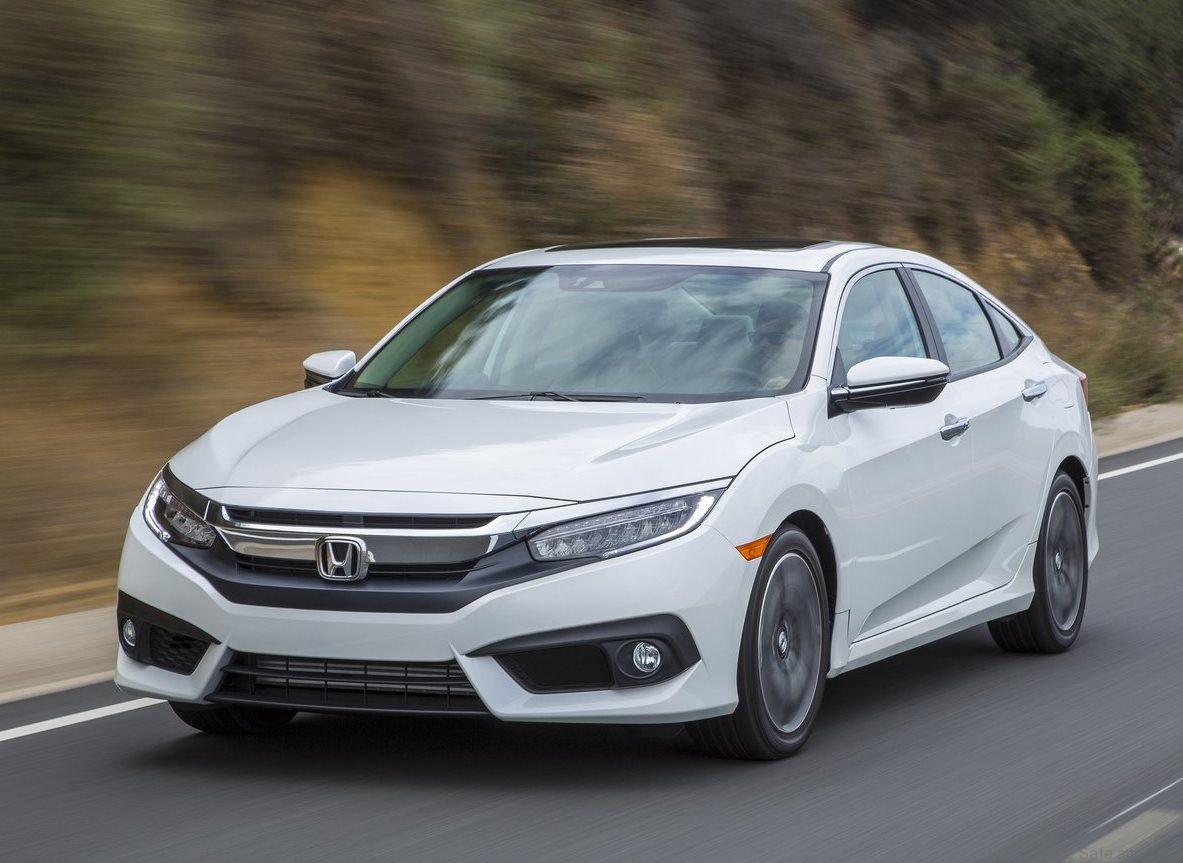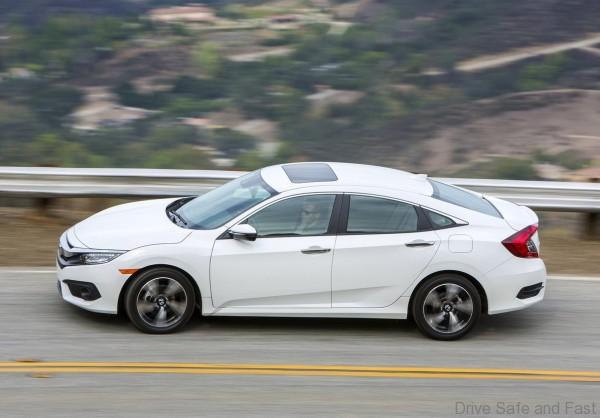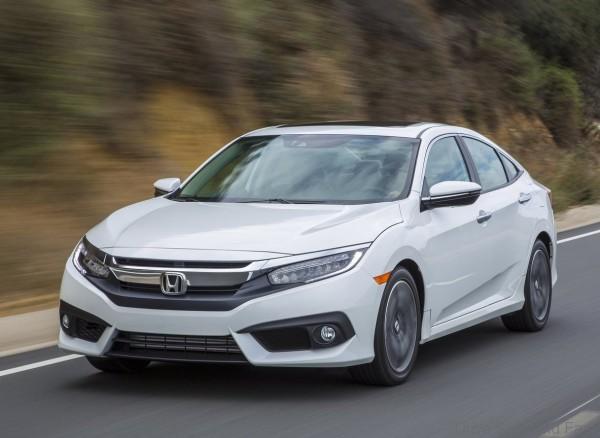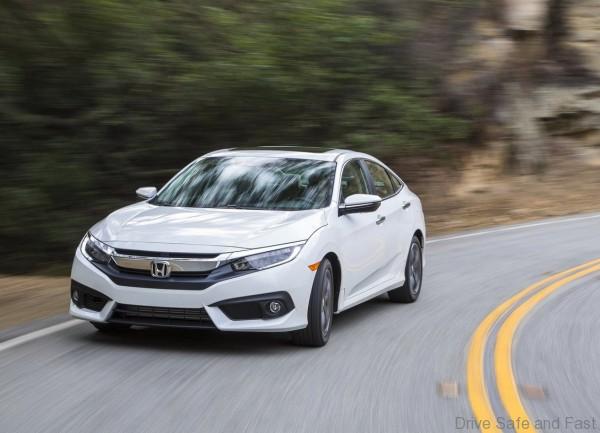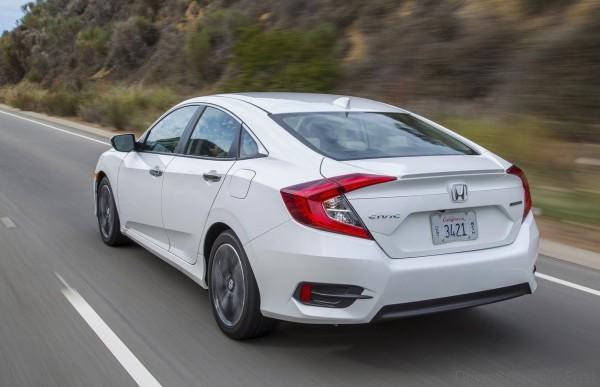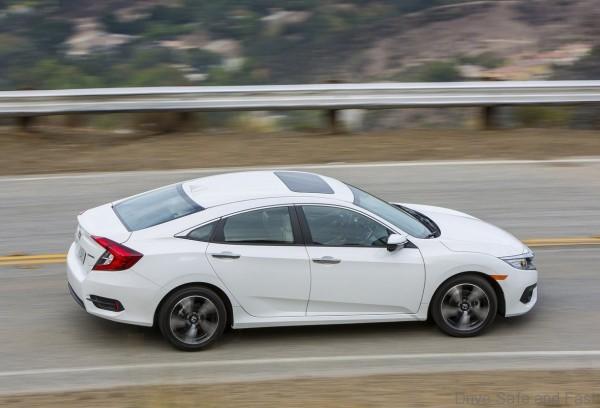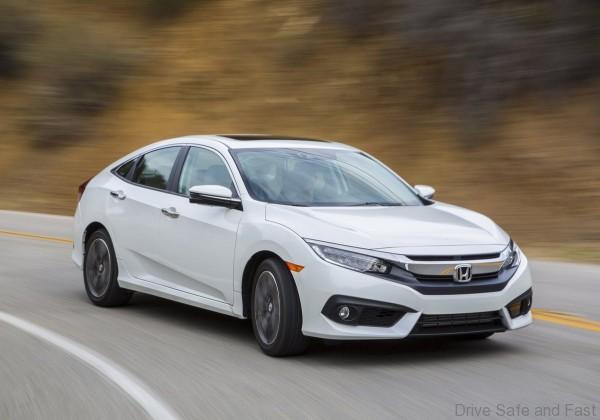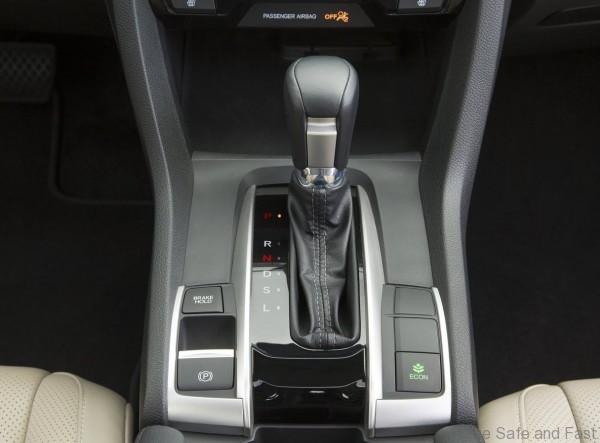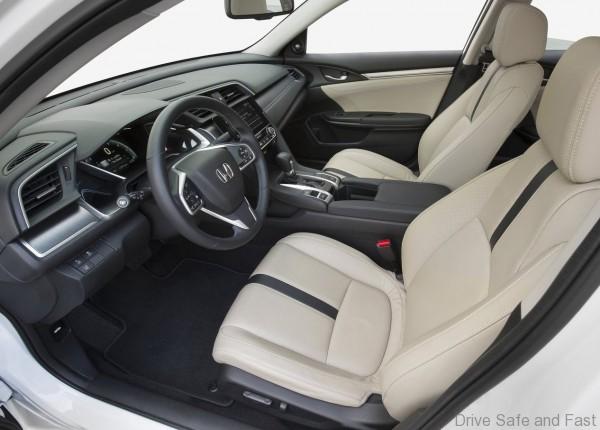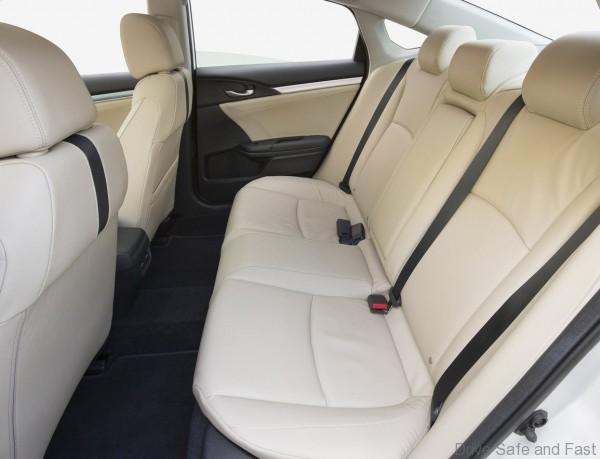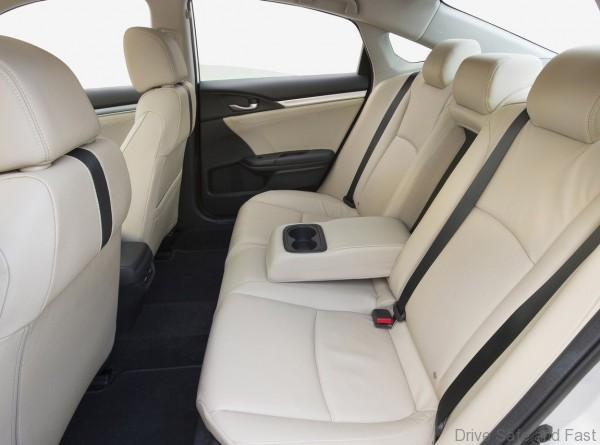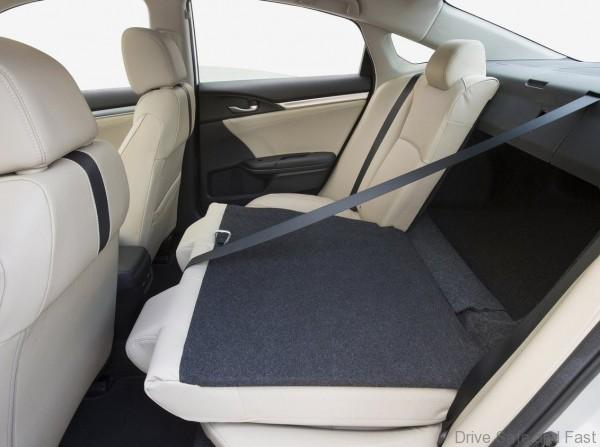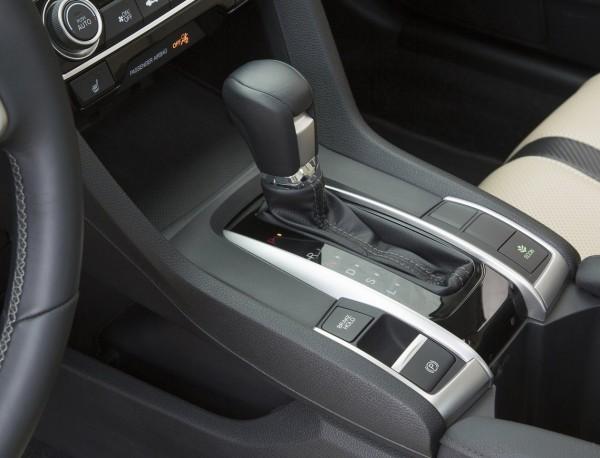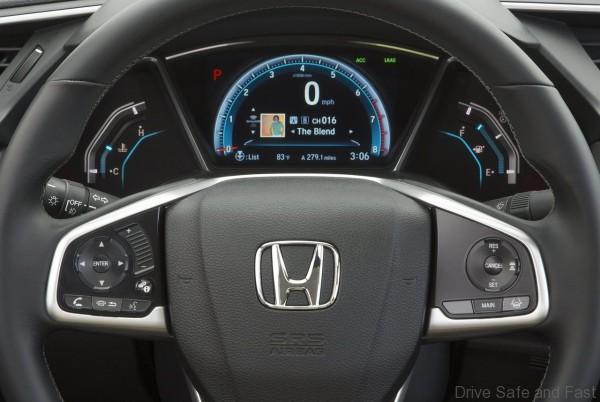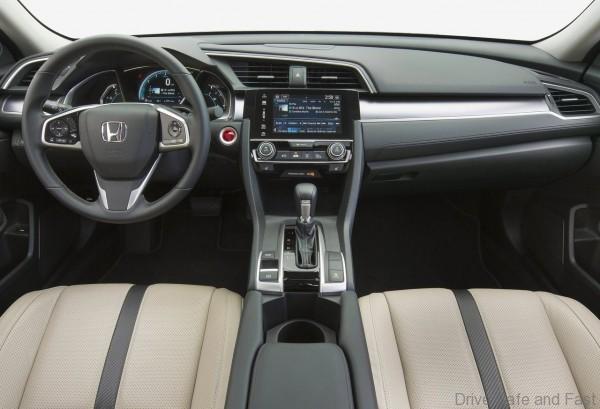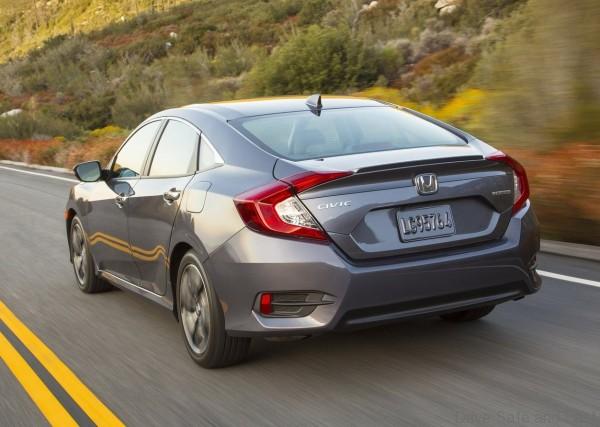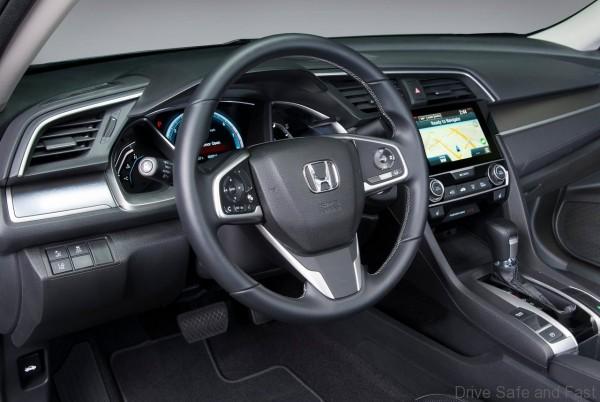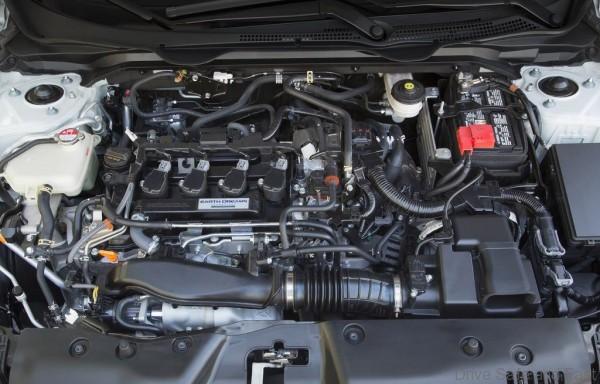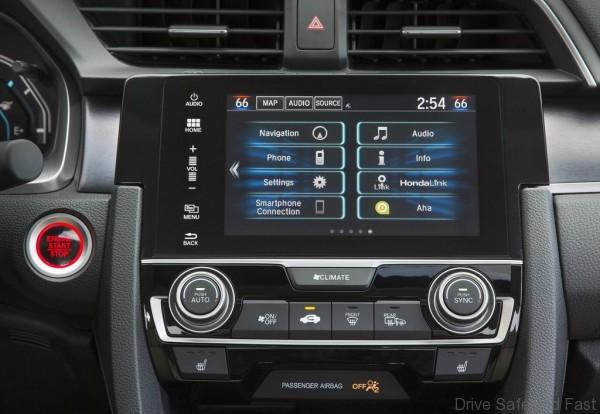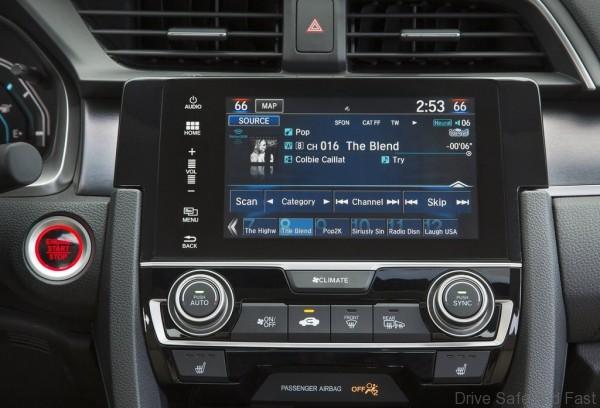This is the 10th-generation Honda Civic which has just been unveiled in North America. This all new Honda Civic represents one of the most comprehensive and ambitious new-model developments ever undertaken by Honda, requiring an unprecedented commitment of R&D resources and Honda engineering prowess. While the development of the Civic Sedan was led by a North American team – a first for Honda and Civic – the overall Civic series involves design and engineering teams from Honda R&D, sales and manufacturing operations around the world, especially in North America and Japan, but also in Europe, South America and Asia.
In seeking to realize a “dynamic rejuvenation” of Civic and create a new interpretation “in a league of its own,” as the development team defined its mission, Honda engineers set out early during platform development to benchmark the world’s best C-segment vehicles—not only products in Civic’s traditional competitive set, but luxury compact class vehicles such as well.
Their evaluation of the world’s best products involved extensive real-world testing, ultimately targeting European luxury vehicles for the new Civic’s ride, handling, steering and NVH (noise, vibration and harshness), and also its interior quality and refinement.
Achieving these lofty aims while meeting requirements for an affordable compact car, in terms of cost, fuel efficiency and manufacturability, stretched the limits of the global Civic team’s engineering capability and demanded new thinking and new approaches to body construction, vehicle aerodynamics, powertrain and chassis design. The result of these efforts is a completely reimagined and reinvented new Civic, the sportiest Civic ever, and a new benchmark in the compact class in terms of spaciousness, fuel efficiency, safety features, interior quality and dynamic performance.
What’s New?
Virtually everything about the 2016 Civic Sedan is new – an all-new vehicle architecture, sporty and sophisticated new interior and exterior styling, a more spacious and high-quality cabin, two advanced new engines, and a host of new premium features and technologies.
Further, with the addition of Honda Sensing™ safety and driver-assistive technologies and the first application of Honda turbo engine technology to Civic, the 2016 Civic Sedan offers buyers a wider range of options than ever before. Civic models powered by the new 2.0-liter i-VTEC™ engine are designated as the Civic LX and EX trims. Civic models powered by the new turbocharged 1.5-liter engine are designated as the EX-T, EX-L (with leather-trimmed interior) and new line-topping Civic Touring, which reaches higher into the upper end of the compact car market than ever before.
Exterior Styling
Stylistically, the 10th generation Civic Sedan represents an exciting and dramatic advancement of Honda’s longest-running model. Lower, longer, wider and more muscular than the previous generation, its flowing lines, new signature chromed “wing” front fascia and available premium LED lighting, extended wheelbase and short overhangs brand the new Civic as a leader in its class, both technologically and in design.
In front, aggressive aerodynamics, LED daytime running lights and an available in-line LED headlight array lend the new Civic a modern demeanor.
The muscular, high-tension side profile soars upward from the front wheel arches rearward, with a decisive character line rising through both doors and through the rear wheel arches. A second, lower character line extends from behind the front wheels up through the doors and meets the rear wheel arches, emphasizing the dynamic and emotional design. The new larger and wider wheel and tires further emphasize Civic’s purposeful stance, while the long wheelbase, short overhangs and sweeping cabin greenhouse further add to the dynamic feel of the exterior.
The windshield is flush-mounted to the cowl, improving aerodynamics and quieting the interior. Panel gaps are minimized and the B-pillars are black-finished, with stainless trim surrounding the side windows to visually emphasize the sweeping cabin shape. The side glass is flush with the pillars to reduce wind noise in the cabin, while also improving the quality feel of the new Sedan. Behind the sweeping roofline and C-pillars, the flush-mounted rear window is sleek and shallow, aiding to the new model’s aerodynamic efficiency. While in back, LED “light pipe” taillights continue the wing design motif of the headlights in an unmistakable new Civic persona. A rear lip spoiler adds a sporty flair to the EX-T and above trims.
LED Lighting
In a first for the market segment, all 2016 Civic trims incorporate a wide range of light-emitting diode (LED) exterior lighting features, including standard LED daytime running lights (DRL), LED one-touch turn signals, and LED taillights, brake lights, license-plate light and center high-mounted stop light. Additionally, the Touring trim receives new Honda LED headlights in an in-line configuration and side mirror-mounted LED turn signals.
Power Side Mirrors
Newly designed power side mirrors have a complimentary design and are aerodynamically optimized to reduce wind noise and minimize turbulence. For 2016, the side mirror housings on all Civic models are body-colored. The Civic EX and above trims add heated side mirrors and the Touring trim further adds integrated LED turn indicators. The side mirrors can be manually folded for greater convenience in tight parking situations.
Expanded View Driver’s Mirror
The Expanded View Driver’s Mirror is standard with passenger side Honda LaneWatch™ (below) included on EX and above trims.
Honda LaneWatch™
The Civic EX and above trims include Honda’s LaneWatch™1 display that uses a camera located at the bottom the passenger-side exterior mirror to display a wide-angle view of the passenger side roadway on the Display Audio screen. The image appears when the right turn signal is activated, or when a button on the end of the turn signal stalk is pressed.
Integrated Rear Window Antenna
Bonded onto the rear window is a wire-type antenna that is optimized to help deliver excellent radio reception without the negative impact on vehicle aerodynamics that would be caused by a traditional mast antenna.
Power Windows and Locks
Power windows are standard equipment on all Civic models and include auto-up and -down operation on the driver and front passenger’s windows. Power locks are standard, and a customizable auto-locking feature can be configured using the Driver Information Interface and steering wheel-mounted controls.
Smart Entry and Push Button Start/Stop
The Civic in EX and above trims include the upscale convenience of Smart Entry & Push Button Start/Stop. The system simplifies approaching, entering and operating the Civic. To gain entry, the driver/passenger simply pulls either of front door handles while the remote in his or her possession.
Remote Engine Start
Civic EX trims and above feature standard remote engine start. This enables drivers to start their Civic in advance of the drive, thereby activating the climate control system with a target temperature of 72 degrees before they get to the vehicle – particularly helpful in extreme hot- or cold-weather conditions. The system will automatically operate the heater, front and rear defrosters, front heated seats (if equipped), heated side mirror, and air conditioning as needed.
Smart Wipers
Laws in some states require drivers to turn on the headlights when the wipers are operating in the rain. In all trims, the new Civic helps its driver comply with these laws by automatically illuminating the headlights when the wipers are activated in rainy conditions (with headlight switch in Auto).
Details include:
- The light sensor detects the ambient brightness and determines when to turn on or off the headlights, while also increasing the illumination of the wiper switch and instrumentation for good visibility.
- If rain is intermittent, the lights stay on for a predetermined interval before automatically turning off again.
- Operation is shown via an indicator on the instrument panel.
- The sensitivity can be controlled by a setting in the MID.
Rain Sensing Wipers
In a first for Civic, the Touring trim includes rain-sensing wipers that automatically activate if water is detected on the windshield.
Details include:
- The rain sensor detects precipitation on the windshield and controls the wipers based on quantity of water detected.
- The sensitivity can be controlled by adjusting the intermittent wiper.
Capless Fueling System
A first for Civic, capless fueling eliminates the fuel cap, meaning that fueling the vehicle simply requires opening the fuel lid, refueling, and then closing the lid. This smart and easy-to-use design eliminates the need to touch a dirty fuel cap, reduces the possibility of damaging the vehicle’s paint with the fuel cap or tether, or forgetting the fuel cap at the gas station. It also eliminates the possibility of activating an emissions warning by failing to properly re-install the fuel cap. And finally, the capless fueling system allows the use of a smaller fuel-cap door, which cleans up the lines of the vehicle. The fuel door unlocks with a handle remote release inside the vehicle.
Exterior Colors
All 2016 Civic Sedan trims are available in nine exterior colors including four new metallic colors and one new pearl color. All colors have a strong character, offering expressive contrasts that complement the Civic’s body-panel curves and angles, while also exhibiting a smart luxury appearance. The colors are:
- Luna Silver Metallic (new)
- Aegean Blue Metallic (new)
- Cosmic Blue Metallic (new)
- Burgundy Night Pearl (new)
- Taffeta White
- White Orchid Pearl
- Modern Steel Metallic
- Crystal Black Pearl
- Rallye Red
The exterior colors are keyed to the 2016 Civic’s three new available interior colors:
- Black
- Gray
- Beige
Interior
Benefitting from Honda’s vehicle packaging expertise, the Civic interior – its spaciousness, smart design, comfortable fit and intuitive controls – has always been a competitive strength. The new Civic interior takes that concept forward with new levels of quality, refinement and spaciousness for Civic and the compact class.
With 97.8 cubic feet of passenger cabin volume, the Civic tops the compact-class for interior space and comfort, with class-leading headroom, legroom, shoulder clearance and side head clearance. Class-leading forward visibility of 84.31 degrees is aided by new, ultra-thin A-pillars, and rear-seat passengers will appreciate newly shaped front seats with a narrower upper profile (in the shoulder area) and smaller headrests that lend the rear cabin a more open, airy feel. The reworked instrument panel provides greater knee room for the driver, while rear-seat foot space in improved with an increase of 27mm in the space between the front seat rails.
The Civic Sedan has a trunk capacity of 15.1 cubic feet – 2.6 cu-ft. larger than the previous model and among the largest in the competitive class. Spacious enough to easily accommodate four large golf bags, the new trunk area is easier to access and use, with a lower lift-over height and wider opening. The Civic LX features a one-piece rear folding seatback, while EX and above trims feature a 60/40 split and folding rear seatback. The shape of the trunk pass-through is now more rectangular with a 20-percent increase in area.
Interior Materials
The new Civic interior takes the refinement of Honda’s most affordable sedan to a new level with high-quality premium touches and upscale materials applied liberally throughout. Highlights include a soft-touch instrument panel upper surface, door pad deck seams and soft door upper panels. Fit, finish and materials have received close attention, and soft leather seating is standard on EX-L and Touring trims.
Interior Design
The new Civic interior blends a dynamic and wide layout with smoothly integrated technology features and-high quality materials. All Civic models have handsome new instrumentation, while EX and above trims feature a full-color 7-inch Driver Information Interface (DII) display, and 7-inch color touchscreen Display Audio system with a clean and sleek appearance. The Civic has always been known for its user-friendly design, and the new generation builds on that reputation. With completely redesigned packaging, the Civic has a more open roomy feel assisted by such design changes as the backs of the front seats having new sleek styling giving rear passengers a spacious feeling. A redesigned instrument panel made possible a more compact climate control system opens up added knee room, and the tandem distance (distance between the front and rear seat hip point) is increased by 1.8 inches. The rear seat knee clearance was also increased, by 2.17 inches.
All important systems and controls in the Civic are positioned within easy reach of the driver. Controls for the systems used most frequently – audio, cruise control, Bluetooth® HandsFreeLink®, available navigation system with voice recognition and intelligent Multi-Information Display – are conveniently positioned on the steering wheel. The main instrumentation is an easy-to-read analog design, supplemented with digital and graphic displays. Typical of Honda interior design, the soft-touch switchgear of the Civic is engineered to deliver a high-quality feel and positive action.
Interior Colors
The Civic’s interior palette is sophisticated and coordinated and is offered in new black, gray or beige colors – fabric in the LX, EX, EX-T, leather in the EX-L and Touring.
Front Seats
The Civic’s all-new front bucket seats are designed to provide welcoming support for a wide range of body types, along with secure lateral support for cornering. New seat frame designs are 17-percent lighter, more comfortable and more adjustable. A relocated seatback recline pivot point improves comfort, and the range of the seat bottom height adjustment has been increased by 10mm (0.4 in). A new available adjustable thigh support for the driver’s seat offers 14-degrees of tilt. To help improve the forward view and create a feeling of openness for rear seat passengers, the front seatbacks have a narrower upper profile and smaller headrests.
Center Console
The Civic interior offers a range of convenient storage features for the driver and passengers. The center console is specially engineered to offer a sporty appearance coupled with the versatile usability you might expect in an SUV. With the prevalence of smartphones in most people’s lives, the console is engineered around a “tech center” theme. Up front, it has a 2-tier smartphone tray with a wire management pass-through for organized connectivity. EX and above trims have a rubber mat to help secure a phone and include LED lighting for nighttime visibility. There’s also an additional phone storage pocket on the driver’s side.
The new electronic parking brake replaces a conventional manual parking brake lever, freeing up more console space for a larger armrest and greater storage space. The main storage compartment is topped by a sliding, deeply padded armrest that features an added inch of adjustability, compared to the previous Civic. A pair of cup holders are centrally located, and can accommodate large 42-ounce cups when the padded armrest is placed in the rearmost position. By sliding the adjustable cup holder rearward, there’s space to accommodate even a large sports drink bottle. Inside the console, a small item tray slides fore and aft the full length of the console. With the cup holder removed, the console offers a class leading 7.2-liters of storage, enough to accommodate iPads and other large items.
Trunk
The Civic Sedan has a trunk capacity of 15.1 cubic feet – 2.6 cu-ft. larger than the previous models, and among the largest in the competitive class. Spacious enough to easily accommodate four large golf bags, the new trunk area is easier to access and use. The liftover height has been reduced by an inch, and the opening is wider and longer front to rear. Inside, the cargo floor is 2.8 inches longer front to rear, and the vertical height of the cargo compartment has increased by 1.6 inches. The Civic LX features a one-piece rear seatback that can be lowered to expand the cargo area, while EX models and higher have a 60/40 split and folding rear seatback. The shape of the trunk pass-through is now more rectangular, and with a 20-percent increase in area, from 2.9 sq-ft. to 3.5 sq-ft., loading long items is much easier. The trunk is carpeted and lined, and a temporary spare is located in a well under a removable section of the cargo-area floor.
Steering Wheel
The steering wheel, leather-wrapped on EX-L and Touring models, incorporates the most commonly used controls, allowing the driver to keep their hands on the wheel and their attention on the road. Bluetooth® HandsFreeLink® and audio system controls are located on the left side of the steering wheel, and include a new touchpad control that makes is easy to scroll and select items that appear on the audio screen. Cruise control controls are on the right and Driver Information Interface (DII) controls are located on the left side. Trims with Honda Sensing™ have LKAS and ACC controls located on the right side of the steering wheel as well. In all trims, the steering wheel offers manual tilt and telescopic adjustment.
Power Windows, Lock and Mirrors
Power windows are standard equipment on all Civic models and include auto-up and -down operation on the driver’s and front passenger’s windows. Power door locks and power mirrors are standard equipment on all Civic models. Civic EX and above include heated exterior mirrors. Smart entry is standard on Civic EX and above trims.
Climate Control Systems
For the first time ever, all Civic models have a standard automatic climate control system. The new system offers a 10-percent improvement in warm-up time compared to the previous system and now features a refrigerant with a much lower GWP (Global Warming Potential). To help conserve energy, the system employs a new Variable Displacement Compressor (VDC). Unlike a conventional compressor which can only operate at 100-percent and must be switched on and off frequently to conserve fuel when the cooling load is relatively low, the VDC can vary its output based on the cooling needs, resulting in greater efficiency, reduced drag on the engine and smoother climate-control performance.
Civic EX-T and above trims include dual-zone operation, for the optimal comfort of both the driver and front-seat passenger; and in addition to physical controls, incorporate climate control functions in the Display Audio touchscreen on EX and above trims.
Sliding Sunvisors
To provide more flexible shading from the sun, all Civics now come standard with sliding sunvisors. The driver and front passenger sunvisors can now be moved along their mounting shafts, with 3.9 inch range of motion, to provide perpendicular shade for the eyes even when the front seats are in their rear-most position.
Meters
The Civic LX has analog instrumentation with large tachometer, flanked by a coolant-temperature gauge on the left and fuel-level gauge on the right. A digital speedometer is positioned in the center of the tachometer. EX models and above have a central Thin-Film Transistor (TFT) Driver Information Interface (DII) color display that depicts an analog tachometer, digital speedometer and additional selectable information.
The gauge package progressively illuminates to give the driver a welcoming feel upon entry. When the door is first opened, the instrument lighting illuminates and then brightens progressively to 100-percent illumination when the ignition is switched on. The illuminated instrument panel then comes alive, indicating that the car is ready to go. At the end of the drive, the instrument lighting dims progressively.
Driver Information Interface (DII)
The Civic instrument panel provides important vehicle information via a Driver Information Interface (DII) positioned centrally in the meter panel. Controls positioned on the right side of the steering wheel allow the driver to cycle the DII display through multiple screens of information from sources including LKAS, ACC and more, when equipped. The Maintenance Minder™ system alerts the Civic driver of upcoming maintenance needs via the DII and should a fault occur with the vehicle, specific warning information will appear. The display indicates when to change the oil, air cleaner, transmission fluid, spark plugs or coolant, as well as when to rotate the tires.
Engine Immobilizer
Complementing the remote entry system is a standard engine-immobilizer system. A special electronically coded key prevents the car from being started-even if a mechanical duplicate of the key is used. A transponder, built into the key, signals the immobilizer control unit that the key is genuine. If the car is hot-wired, or an unauthorized key is used, the engine will not start.
Continuously Variable Transmission Controls
When equipped with the available Continuously Variable Transmission, the Civic has a conventional straight-gate shifter that is intuitive and easy-to-use and takes up little space in the center console. New LED indicator lights on the console make the current gear setting and selection clear and simple.
Powertrain
With two advanced new engines and new and updated manual and Continuously Variable Transmissions, the 2016 Civic offers a range of new powertrain choices that combine fuel efficiency and fun-to-drive performance.
The all-new base engine is a 2.0-liter 16-Valve DOHC i-VTEC® that is related to the 2.4-liter engine offered in the larger Accord. With its larger displacement (replacing Civic’s previous SOHC 1.8-liter engine) it offers more horsepower and torque than any previous base Civic engine in the U.S. The new 2.0-liter engine is rated at 158 horsepower at 6500 rpm and 138 lb-ft. of torque at 4200 rpm (an increase of 15 horsepower and 9 lb-ft. of torque). The 2.0-liter engine is paired with a new 6-speed manual transmission (LX) or a Continuously Variable Transmission (CVT) for efficient automatic operation.
For drivers looking for even greater performance coupled with equally high EPA fuel economy ratings, for the first time ever, the Civic is available with a turbocharged engine. The 1.5-liter 16-valve DOHC direct-injected turbocharged powerplant is rated at 174 horsepower at 5500 rpm with torque output an impressive 162 lb-ft. of torque between 1,800 and 5,500 rpm.
Both engines are LEV3-ULEV125/LEV3-SULEV 30 emissions compliant. The new, more efficient engines and transmissions, along with improved aerodynamics and a major reduction in running resistance, result in substantially enhanced performance and fuel efficiency.
2.0-Liter In-Line 4 Cylinder
Related to the European Civic Type-R 2.0 liter turbo charged engine, the Civic’s new standard 2.0-liter i-VTEC powerplant produces more horsepower and torque at all operating speeds compared to the 1.8-liter engine it replaces. The new engine also is anticipated to help the Civic receive superior EPA MPG ratings. The new 2.0-liter engine is rated at 158 horsepower at 6,500 rpm and 138 lb-ft. of torque at 4,200 rpm. The anticipated EPA fuel economy rating is 27/40/31 mpg city/highway/combined with 6-speed manual transmission, and 31/41/35 mpg with CVT.
Turbocharged 1.5-Liter In-Line 4 Cylinder
The Civic’s available new DOHC 1.5-liter engine is the first turbocharged engine ever to be offered in a Honda-brand automobile in America. With direct injection, low-inertia Mono scroll turbo system with electrical waste-gate and dual Variable Valve Timing Control (VTC), the turbocharged Civic powerplant develops the horsepower and torque of a much larger engine, and is anticipated to help the Civic receive excellent EPA estimated fuel economy ratings.
The turbocharged 1.5-liter engine is rated at 174 horsepower at 5,500 rpm with 162 lb.-ft of torque between 1,800 and 5,500 rpm. The Civic Turbo is anticipated to be rated by the EPA at 31/42/35 mpg.
Low Inertia Mono Scroll Turbo System with Electric Wastegate
The turbocharged Civic engine employs a small-diameter turbine for maximum responsiveness. The Mono scroll housing design helps the turbo build boost even at relatively small throttle openings and low rpm. The electrically actuated wastegate allows boost pressure to be precisely controlled.
A large air low-restriction intercooler is positioned low in the front of the car where it receives unobstructed airflow when the vehicle is in motion. Intake air travels from the air filter, to the turbo compressor, on to the intercooler, then to the engine’s intake ports. The intercooler helps reduce the temperature of air entering the engine, making it denser for greater performance. To reduce weight, the turbo system is plumbed with rigid, lightweight resin composite inlet pipes to carry intake air to and from the intercooler.
ECON Mode
Every 2016 Civic is equipped with a green ECON button located on the center console near the shift lever. When the button is pushed to activate ECON mode, several operating characteristics of the vehicle are modified for enhanced fuel efficiency. The Drive-by-Wire throttle system provides more gradual response, and to save additional energy, the climate control’s fan speeds are lowered incrementally and other climate control system characteristics are altered based on the conditions. Another push of the ECON button reverts all systems to their normal mode.
Friction Reducing Technology
Both of Civic’s engines make use of new friction-reducing technologies designed to improve engine efficiency. The outer skirts of lightweight aluminum pistons feature a low-friction coating applied in a unique pattern application. The result is reduced overall friction as the pistons move within the cylinder bores. Plateau honing further lowers the friction level between the pistons and the cylinders by creating an ultra-smooth surface. Plateau honing is a 2-stage machining process that uses two grinding processes instead of the more conventional single honing process. This also enhances the long-term wear characteristics of the engine. Low viscosity oil (0W-20) also reduces friction. Other contributors to overall operating efficiency are a special two-stage oil pump relief valve, low-friction oil seals, special low-drag piston ring design, low-friction cam chain and a lightweight crankshaft.
Drive-by-Wire Throttle System
The Civic’s Drive-by-Wire throttle system replaces a conventional throttle cable with smart electronics that “connect” the accelerator pedal to a throttle valve inside the throttle body. The result is less under-hood clutter and lower weight, as well as quicker and more accurate throttle actuation. Plus, a specially programmed “gain” rate between the throttle pedal and engine offers improved drivability and optimized engine response to suit specific driving conditions.
Honda’s Drive-by-Wire throttle system evaluates the current driving conditions by monitoring throttle pedal position, throttle valve position, engine speed (rpm) and road speed. This information is used to define the throttle control sensitivity that gives the Civic’s throttle pedal a predictable and responsive feel that meets driver expectations.
Emissions Control
Both 2016 Civic engines meet the tough EPA LEV3-ULEV125/LEV3-SULEV30 emissions standards, and are certified to this level of emissions performance for 120,000 miles.
Maintenance Minder™ System
To eliminate unnecessary service stops while ensuring that the vehicle is properly maintained, the Civic has a Maintenance Minder™ system that continually monitors the vehicle’s operating condition. When maintenance is required, the driver is alerted via a message on the Multi-Information Display (MID) on the LX trim or Driver Information Interface (DII) on EX and above trims.
The Maintenance Minder™ system monitors operating conditions such as oil and coolant temperature along with engine speed to determine the proper service intervals. Depending on operating conditions, oil change intervals can be extended to a maximum of 10,000 miles, potentially sparing the owner considerable expense and inconvenience over the life of the vehicle. The owner-resettable system monitors all normal service parts and systems, including oil and filter, tire rotation, air-cleaner, transmission fluid, spark plugs, coolant, brake pads and more. To reduce the potential for driver distraction, maintenance alerts are presented on the DII only when the ignition is first turned on, not while driving.
Continuously Variable Transmissions (CVT)
Two different CVT transmissions are offered in the new Civic to best suit the power output and operating characteristics of each available engine. Both Continuously Variable Transmissions (CVT) offer smooth and predictable gear ratio transitions and excellent acceleration matched with efficient low-rpm cruising. A wide ratio spread results in strong acceleration performance coupled with reduced engine rpm at high road speeds.
Each CVT is comprised of an engine driven torque converter that in turn drives two variable-width pulleys connected by a steel belt. With its angled inner faces, the belt can circle the angled pulley faces at varying diameter depending on the pulley width, which alters the effective ratio between the pulleys. Since there are no steps in the pulley faces, the range of possible gear ratios is essentially infinite. This ultra-fine control of the gear ratio is the key to the CVT’s greater efficiency over a conventional automatic transmission with a limited number of discrete gear ratios. Instead of approximating the correct ratio for the conditions like a conventional automatic does, the Civic CVTs can precisely select the optimum ratio from moment to moment without steps or slippage. Computer control of the transmission allows the ratio between the pulleys to be altered almost instantly to best suit the driving conditions and accelerator pedal setting.
Continuously Variable Transmission for 2.0L i-VTEC
The Civic LX and EX which are powered by the 2.0-liter engine offer a CVT (available in the LX and standard in the EX) that is a refined version of the CVT that was offered in the previous generation Civic. It features a retuned torque converter, and a new generation of G-Design shift logic.
Continuously Variable Transmission for 1.5L Turbo
Turbo Civic models offer a CVT that is an evolution of the CVT transmission that is offered in Accord 4-cylinder models. In this application, the transmission’s final gear ratio is 4.69-percent taller than the Accord CVT on which it’s based, to allow for lower engine rpm while cruising. A new generation of G-Design shift logic aids acceleration and has a more familiar driving feel. A new turbine twin-damper design for the torque converter provides tighter control and helps reduce turbocharger lag as the vehicle accelerates.
G-Design Shift Feature
Both available Civic CVTs are designed to provide the optimum gear ratio for the driving conditions, and to offer a more natural driving feel than some previous CVT transmissions that may have something of a disconnected “rubber-band” feel compared to a conventional automatic transmission.
The Civic CVTs have a new generation of special G-design shift logic that is designed to offer more immediate acceleration response than either conventional automatics or other CVT designs. When abruptly applying power from a steady-state cruising speed, both Civic CVTs immediately send power to the drive wheels while simultaneously adjusting the gear ratio (seamlessly and progressively downshifting) to smoothly bring the engine to its horsepower peak in a linear way.
By comparison, a conventional automatic is slower to respond and loses time making multiple downshifts. Since the automatic transmission has a limited number of separate, discrete ratios, even when fully downshifted, it can only approximate the optimum engine rpm as speed increases. This cuts into acceleration.
During full throttle acceleration, the new generation of G-Design shift logic employs stepped ratios as the vehicle speed increases. This helps give the transmission a more “connected” feel as the engine rpm and vehicle speed increase together. This stepped operation also improves acceleration performance incrementally.
CVT Automatic Modes
The transmission can be operated in three different fully automatic forward modes with the console-mounted straight-gate shifter. The D mode is ideal for most driving situations, and combines fuel efficiency with smooth operation and responsive power when needed. The S mode is for more performance-oriented driving, and features more aggressive transmission mapping to keep engine rpm higher for greater acceleration and response. The L mode is ideal for situations when additional engine braking is desired, such as in mountainous driving.
S-Range Control
To allow the driver to alter the operation of the CVT, the console-mounted gear selector includes an “S” or Sport mode that provides a sport-shift schedule that delays upshifting for more available power, and provides greater engine braking.
Chassis
The 2016 Civic Sedan utilizes the most sophisticated chassis design in model history, delivering quicker and more accurate steering, more responsive handling, and exceptional ride quality that exceeds the mainstream, compact-car class to challenge even luxury C-segment products.
Key suspension upgrades include a sophisticated new multi-link rear suspension and rigid rear subframe; fluid-filled suspension bushings that greatly enhance ride quality while providing robust isolation from road vibration; stabilizer bars with bonded bushing mounts for improved body control; dual-pinion, variable ratio Electric Power Steering (EPS) that enhances steering feel, performance and comfort; and a Straight Driving Assist feature that reduces steering effort when driving on a sloped or crowned road. Additional new Civic chassis features include Agile Handling Assist and an Electric Parking Brake (EPB) with Automatic Brake Hold.
Front and Rear Suspension
The 2016 Civic suspension system provides agile and direct handling that puts the Civic at the top of its class, and in the league of benchmarked European luxury-class competitors. The system uses a combination of front MacPherson struts and an all-new rear multi-link with new rigid subframe. Using a strut-style front suspension improves the room available for crash reinforcement, and the multi-link rear suspension helps maximize second-row seating and cargo space – all while also providing outstanding handling characteristics and ride quality. Front and rear stabilizer bars on all trims improve turn-in response while reducing body roll during cornering. The stabilizer bars are bonded to their mounting bushings and use low-friction connecting links for smoother operation. The 2016 Civic has a 14mm (0.6 in) lower center of gravity, helping to improve both handling agility and rollover resistance.
MacPherson Strut Front Suspension
The MacPherson strut front suspension is engineered to provide engaging performance and a responsive feel for the driver. Performance-calibrated geometry ensures a high degree of quickness and precision, smoothness and stability. The lower suspension arms are connected to the subframe and to the body via fluid-filled bushings, which provide the ideal combination of handling responsiveness and precision, along with maximum isolation from road noise, vibration and harshness (NVH). All front suspension arms and the front hub carriers are steel, and all Civic Sedan trims use a tubular front stabilizer bar.
Multi-Link Rear Suspension
The multi-link rear suspension includes stamped-steel arms, cast aluminum hub carriers and a stabilizer bar. Mounted on a rigid subframe, a first for Civic, the new rear suspension provides agile handling, both during normal driving and in emergency maneuvers, together with a flat ride. The trailing arms are located on the unibody in fluid-filled bushings for exceptional control of noise, vibration and harshness (NVH) while maintaining precise handling. All Civic Sedan trims use a solid rear stabilizer bar for improved crisp turn-in and body roll control.
Hydraulic Suspension Bushings
In a first for Honda, the 2016 Civic suspension uses fluid-filled bushings to provide superior ride isolation as well as chassis vibration control. All Civic models utilize front fluid-filled bushings and the EX-T and above trims additionally use rear fluid-filled bushings. These bushings are specifically tuned to provide minimum vibration transfer to the occupants, raising the new Civic to the top of its class in noise, vibration and harshness (NVH) reduction.
In front, the lower control arms pivot in the fluid-filled bushing, which is designed to absorb road harshness and vibration while still retaining the exacting precision required for sharp, nimble handling. For the front suspension only, a specially ventilated under-cover allows airflow to cool the bushings, ensuring more consistent performance in all ambient temperature conditions, as well as enhanced long-term durability.
An additional duct, located near the middle of the aluminum front under-panel, cools the engine’s torque rod bushing, likewise reducing operating temperatures and ensuring longer performance.
Dual Pinion Variable Ratio Electric Power-Assisted Rack-and-Pinion Steering (EPS)
Another Civic first, the Electric Power Steering (EPS) incorporates dual pinion gears and a variable gear ratio for improved steering feel, performance and comfort that surpasses the class.
The dual pinion steering provides substantially improved feel compared to the previous-generation Civic. Compared to a traditional single-pinion steering system, the dual pinion EPS utilizes the physical steering input from the driver as well as from a supplemental electric motor. A non-contact torque sensor measures the driver’s steering effort and an ECU determines how much electric motor assist to add, with the result being a seamless, natural feeling steering in all situations.
The steering ratio is variable over a 17-percent range with a final full off-center rotation ratio of 10.93:1. This provides a quick 2.2 turns lock-to-lock compared to 3.1 turns lock-to-lock for the previous Civic, significantly reducing the steering effort when parking or maneuvering. Also contributing to the enhanced steering performance and feel of the 2016 Civic Sedan, the steering mount stiffness is higher, and the 30mm steering column diameter (up from 22mm on the previous generation Civic) also provides greater stiffness.
Straight Driving Assist
A new Honda technology, Straight Driving Assist reduces the steering effort required when driving on a sloped or crowned road. When the Straight Driving Assist system detects that steering effort is being applied to keep the car driving along a slope, the Electric Power Steering system applies motor assist. This reduces the muscle effort required to maintain the desired direction on the sloped road to the same level as is required on a flat road.
4-wheel Disc Brakes with ABS, EBD and Brake Assist
In a first for Civic, all trims are equipped with 4-wheel disc brakes. All systems incorporate 4-channel ABS, Electronic Brake Distribution (EBD) and Brake Assist as standard equipment. The system provides a comfortable and refined feel at low speeds, predictable and easy operation on the highway, a sporty, fun-to-drive feel on winding roads, and a reassuring high-performance stopping in emergency situations. Compared to the previous-generation, the 2016 Civic’s brakes require less pedal travel, provide a firmer pedal feel under normal conditions, and deliver greater efficiency.
The 4-channel Anti-lock Braking System (ABS) independently modulates braking power at each wheel to help the driver retain steering control during heavy braking. The Brake Assist system recognizes emergency braking situations and almost instantly applies full braking force when appropriate to help shorten braking distance.
All 2016 Civic trims are equipped with 11.1-inch diameter ventilated front brake rotors (0.9-inch rotor thickness) clamped by single-piston brake calipers. The rear disc brakes incorporate 10.2-inch diameter solid rotors (0.4-inch rotor thickness) paired with single-piston brake calipers. The low-friction design of the brake calipers reduces energy losses when the brakes are not in use, directly improving fuel efficiency.
In another first for Civic, a 5-percent-larger master cylinder piston diameter (22.2mm vs. 20.6mm on the previous Civic) contributes to the short, firm pedal stroke and excellent feel, while also maintaining the power of the braking system.
Vehicle Stability Assist™ (VSA®) with Traction Control
Vehicle Stability Assist™ (VSA®) is an Electronic Stability Control system that works in conjunction with the Civic Sedan’s Drive-by-Wire™ throttle and its 4-channel ABS systems to enhance control capability while the vehicle is accelerating, braking, cornering or when the driver makes a sudden maneuver.
VSA also provides a limited-slip differential effect for the driving wheels by applying braking force to a slipping wheel, thereby redirecting driving force to the wheel with more traction. While the driver can reduce the traction control effectiveness allowing more wheel slip during stuck condition by pressing the VSA button, ABS remains fully operational at all times.
Agile Handling Assist
A Civic first and standard on all trims, Agile Handling Assist selectively uses the vehicle’s brakes to improve initial turning response and overall cornering ability. Agile Handling Assist utilizes brake vectoring to improve corner traceability and confident handling feel. By applying braking force to the inside wheels during cornering at high lateral G, the system creates a yaw moment, thus generating more turning force and reducing understeer.
Hill Start Assist
The Hill Start Assist function helps to prevent the vehicle from rolling backwards when the driver switches from the brake pedal to the accelerator pedal while the vehicle is stopped on a hill. Hill Start Assist automatically activates when the vehicle senses a certain incline and is fully stopped in any forward gear when facing up hill or reverse gear when facing downhill. The system uses a longitudinal G-sensor along with a wheel speed sensor to control the hydraulic brake modulator. Hill Start Assist, when activated, will release the brakes when the driver depresses the throttle or if the driver doesn’t press the accelerator after a few seconds.
Electric Parking Brake (EPB)
In a first for both the Honda Civic and its market segment, the standard Electric Parking Brake (EPB) is simpler, more convenient and comfortable to use than a traditional parking brake. The EPB also frees up center console space, allowing a higher console and an extended armrest length.
Engaging the parking brake now requires only a pull on a switch on the center console. To release the parking brake, the driver simply presses on the accelerator pedal (while the seatbelt is buckled) when the transmission is in Drive or Reverse, or else pushes on the parking brake switch while operating the brake pedal.
Besides promoting the use of the parking brake, EPB makes hill starts easier when the Civic is parked on a grade. As with a traditional manually activated parking brake, EPB functions on the rear wheels only. Electric servo actuators are integrated into the rear brake calipers.
Automatic Brake Hold
When activated, Automatic Brake Hold retains brake pressure when the vehicle comes to a stop such as at a traffic light or in heavy traffic. This frees the driver from continually pressing the brake pedal to maintain the vehicle in a stopped position, a significant improvement in driving enjoyment in difficult conditions.
Operating the system requires two simple actions from the driver:
- Activating/deactivating the system via a switch on the center console
- Pressing on the brake pedal until the vehicle comes to a stop
Once these steps are taken, Automatic Brake Hold will indicate engagement and then maintain brake pressure when the vehicle has come to a stop, even if the driver later releases the brake pedal. A green “Brake Hold” icon on the instrument panel illuminates to show that the system is functioning. The Civic then remains stopped – even on a hill – until the driver presses the accelerator pedal. At this point Automatic Brake Hold releases the brakes and the vehicle resumes normal braking function.
Fuel Tank
The 12.4-gallon fuel tank and fuel lines are molded of high-density polyethylene for low weight, freedom from corrosion, impact resistance and fuel vapor losses. The tank and filler pipe are formed as a single unit, reducing weight and complexity, while further improving safety in the event of a collision. Additionally, the tank is positioned ahead of the rear wheels to help guard against collision damage. A high-efficiency fuel pump is housed inside the tank, and the fuel filter is a lifetime design that never needs replacement. An integrated baffle system positioned inside the tank reduces the sound of fuel sloshing.
Tire Pressure Monitoring System (TPMS)
The 2016 Civic uses an indirect Tire Pressure Monitoring System (TPMS) that is lighter and simpler than previous systems. Instead of using sensors mounted on each wheel to monitor tire pressures, indirect TMPS uses the existing ABS wheel-speed sensors to continually monitor the rotational speed of each wheel. Because a tire with low pressure rotates more quickly than one with a higher pressure, by comparing these values with a specifically designed computer algorithm, indirect TPMS can determine when a tire is low on pressure. This information is delivered to the driver in the form of a warning symbol on the instrument panel. Special logic included in the TPMS processor is designed to eliminate false warnings.
Exterior Dimensions
Compared to the previous model, the 2016 Civic Sedan’s wheelbase is 1.2 inches longer for improved ride comfort, better second-row seating roominess, and improved ingress and egress. The overall length is up 2.9 inches, improving interior roominess as well as cargo storage capacity. A 1.4-inch shorter front overhang improves both appearance and aerodynamic efficiency, while a 2.9-inch longer rear overhang adds to storage capacity. Fuel efficiency is improved in part due to comprehensive aerodynamic gains throughout the exterior, and even underneath the vehicle.
Increased Trunk Capacity
The 2016 Civic Sedan has a wider and deeper trunk with 15.1 cu. ft. of storage volume, 2.6 cu. ft. (or 20.8 percent) larger than the 12.5 cu. ft. of the previous Civic Sedan. Together with the enlarged passenger volume, this makes the new Civic Sedan best in class in total interior volume.
A low lift-over height of 26.8 inches and a maximum trunk opening width of 39.7 inches improves the ease of loading or unloading bulky items, as does a flat trunk floor, which measures 54.9 inches wide and 40.6 inches deep – all significant improvements over the previous model. The floor and trunk sides are carpeted to help protect cargo during transit, and also to help reduce road noise entering the passenger cabin.
The Civic Sedan’s trunk will accommodate four soft suitcases or four golf bags – one more of each compared to the previous Civic Sedan. For long, narrow items such as skis, the 3.5 sq-ft. trunk pass-through is 20.6-percent larger than before. A removable floor panel hides the temporary spare tire, jack and wrench. A single LED cargo-area light provides illumination when the trunk lid is open.
Advanced Compatibility Engineering™ (ACE™)
As an integral part of the 2016 Civic structure, Honda’s proprietary Advanced Compatibility Engineering™ (ACE™) body-structure enhances occupant protection and crash compatibility in frontal collisions. ACE utilizes a network of connected structural elements to distribute crash energy more evenly throughout the front of the vehicle, thus reducing the forces transferred to the passenger compartment. ACE channels frontal crash energy to both upper and lower structural elements, including the floor frame rails, side sills and A-pillars.
Crash Stroke
A Honda first, the ACE™ structure used on the new Civic features a new crash stroke technology, developed by Honda engineers in the company’s advanced safety research laboratory in Raymond. Ohio. With the new crash stroke structure, in a frontal collision the lower section of the front vehicle frame hinges to direct the engine down and rearward, helping direct crash energy into the vehicle’s floor while also minimizing cabin intrusion. This crucial piece of safety engineering effectively adds 80mm (3.2 in) of additional energy-absorbing “crash stroke” to the front of the vehicle.
Besides helping the Civic aim for the highest ratings in the rigorous federal crash tests, the new crash stroke structure enabled designers to develop the Civic’s body design to feature a short front overhang and short hood-line for a unique and exciting appearance, excellent outward visibility and improved handling.
Improved Body Rigidity
Compared to the previous Civic generation, the new 2016 Civic Sedan body’s global bending rigidity increases 19 percent and its torsional rigidity increases 23 percent. The benefits of this increased stiffness are numerous, including the ability to tune the suspension for superior ride and handling performance. The more rigid body structure also directly results in a quieter and more comfortable ride experience for the passengers, with less NVH felt over a wide range of driving conditions. Some key advancements in body structure include:
Aerodynamics
The Civic was designed to have class-leading aerodynamic performance – including 12-percent less drag than the previous Civic generation – which helps improve both fuel efficiency and interior quietness. Computational fluid dynamics (CFD) was used to measure the car’s efficiency during the design phase, followed by scale-model wind tunnel testing and finally by full-scale wind-tunnel testing. Two critical gains from this process include a 15-percent reduction in drag (CdA) through the management of underbody and engine-room airflow, and another 4-percent CdA reduction through wheel design.
Vehicle Stability Assist™ (VSA®) with Traction Control
Vehicle Stability Assist™ (VSA®) is an Electronic Stability Control system that works in conjunction with the Drive-by-Wire™ throttle and its 4-channel ABS systems to enhance control capability while the vehicle is accelerating, braking, cornering or when the driver makes a sudden maneuver. VSA functions by applying brake force to one or more wheels independently while also managing the throttle, ignition and fuel systems to help the vehicle maintain the driver’s intended path of travel.
The VSA system constantly analyzes data from sensors that monitor wheel speed, steering input, lateral and longitudinal G forces and yaw rate. It compares the driver’s control inputs with the vehicle’s actual response. Whenever the actual response falls outside of a predetermined acceptable range, VSA intervenes with a corrective action. For instance, if VSA detects an oversteer condition, the system may apply braking force to the outside front and rear wheels to counteract the unintended yawing effect. In the event of understeer, VSA may apply braking to the inside rear wheel while reducing engine power to help return the vehicle to its intended course.
VSA also provides a limited-slip differential effect for the front wheels by applying braking force to a slipping wheel, thereby redirecting driving force to the wheel with more traction. VSA is calibrated to function in a near-transparent manner, and in many cases a driver will not even be aware of its operation. However, anytime the system is enhancing vehicle stability, an indicator light flashes in the instrument cluster. While the driver can reduce the traction control effectiveness allowing more wheel slip during stuck condition by pressing the VSA button, ABS remains fully operational at all times.
Motion-Adaptive Electric Power Steering (EPS)
Motion-Adaptive Electric Power Steering (EPS) is standard on all 2016 Civic models. The system incorporates driving stability technology that initiates steering inputs that prompt the driver to steer in the correct direction during cornering and in slippery road conditions. Using vehicle speed and steering angle data, Motion-Adaptive EPS works with Honda’s Vehicle Stability Assist (VSA®)10 and Electric Power Steering to detect instability in slippery road conditions both during cornering and under braking and automatically initiates steering inputs aimed at prompting the driver to steer in the correct direction. This advanced technology supports the driver’s action in operating the vehicle more safely and comfortably.
Two examples of how Motion-Adaptive Electric Power Steering (EPS) functions in conjunction with VSA are:
Stabilizes Vehicle under Braking
This function helps to correct the driver’s steering input to reduce vehicle instability when the driver is braking hard on road surfaces with different friction coefficients (such as pavement that is partially covered with dirt or snow).
Mitigates Understeer and Oversteer
To mitigate potential understeer or oversteer situations, the system helps correct the steering inputs to help the driver trace the curve.
Brake Assist
A function of the VSA® system, the Brake Assist feature recognizes emergency braking situations and almost instantly applies added braking force. This Brake Assist feature is controlled by a special logic in the system that evaluates the pedal application rate and force to recognize a panic stop situation. At that point, the VSA modulator pump increases braking pressure while the pedal is still being pressed to ensure maximum stopping force, an action that can help shorten braking distance.
Advanced 4-Channel ABS with Electronic Brake Distribution
For the first time, all Civic trims are fitted with 4-wheel disc brakes with four-channel anti-lock braking (ABS). The ABS system also incorporates Electronic Brake Distribution (EBD) circuitry that automatically proportions front-to-rear brake force based on the vehicle’s dynamic load on each wheel. Larger front brake disc dimensions and a larger master cylinder improve stopping performance and pedal feel.
Seatbelts
Three-point seatbelts are standard for all seating positions. The front seatbelts are equipped with pyrotechnic pretensioners and load limiting retractors to help minimize injury potential in a frontal collision. When an impact occurs, the automatic tensioner tightens the seatbelt (shoulder and lap) to help hold the seat occupant firmly in position. Each front seatbelt retractor incorporates a load limiter that works in conjunction with the automatic tensioner. The load limiter functions by permitting a small amount of controlled seatbelt slack shortly after the automatic tensioner is activated to limit the peak restraining forces and thereby reducing the potential of serious injury. The front seatbelts also feature adjustable-height shoulder anchors. To help increase seat-belt usage, a reminder for the driver and front passenger has been incorporated into the instrument cluster. After starting the vehicle, a weight sensor detects whether the front passenger seat is occupied. If the driver or front passenger has not already fastened the seat belt, an icon in the cluster illuminates and a chime sounds as a reminder to do so.
Crash Locking Tongue
The Civic’s front seatbelts use a “crash locking tongue” latch plate design that locks the webbing in place during a collision, helping to better restrain the occupant. During normal driving conditions the seatbelt webbing moves freely through the latch plate in the normal manner. However in the event of a collision, forces exerted on the lap and shoulder sections of the seatbelt push the webbing against a “reaction surface” inside the latch plate, locking the webbing in place.
Dual-stage, Multiple-Threshold Front Airbags
Both the driver and front passenger are protected by advanced front airbags (SRS) that incorporate dual-stage and multiple-threshold activation technology. If deployed, these airbags are capable of being inflated at different rates depending on crash severity, seatbelt usage and other factors. Like other Honda vehicles, the driver’s front airbag is located in the steering wheel while the passenger airbag is located on the top of the dash. When deployed, the passenger airbag inflates upward and then rearward to maximize its protective potential while reducing the likelihood of injuries caused by airbag deployment.
Driver’s Spiral Airbag
In a first for the North American market, the 2016 Civic incorporates spiral stitching into the driver’s front airbag. The spiral nature of the airbag promotes early restraint and maintains a constant pressure by reducing volume early and maximizing volume later in deployment.
Front Passenger’s Safety Vent Airbag
A Honda first, the passenger’s front airbag in the 2016 Civic features a new safety vent system that increases safety for the front passenger in a frontal collision involving an airbag deployment. If the passenger is sitting “out of position” – such as leaning forward in the pathway of the airbag deployment – the auxiliary vents remain open, directing a significant amount of gas out and away from the occupant. As a result, the potential for injury from the airbag striking an out-of-position passenger is reduced. However if the passenger is correctly seated, the airbag has an internal tether that will close the auxiliary vents at the necessary time to provide optimal occupant restraint.
Driver and Front Passenger SmartVent® Side Airbags
Side airbags mounted in the outboard area of each front seatback are designed to help provide pelvic and thorax protection for the driver and front passenger in the event of a severe side impact.
In the 2016 Civic, a revised side airbag design allows the side airbags to deploy in a manner that helps mitigate the risk of injury to a smaller seat occupant. This advancement eliminates the need for the previous-generation Civic’s passenger side Occupant Position Detection System (OPDS).
Side Curtain Airbags
All outboard seating positions are protected by side curtain airbags with a rollover sensor system. In the event of a severe side impact, the side curtain airbags deploy from modules in the roof, providing a significant level of head protection in the window area. In the unlikely event of a rollover, a roll-rate sensor, along with multiple G sensors determine the rate of roll and deploy the side curtain airbags accordingly. The side curtain airbags will also deploy and provide head protection in frontal impacts as necessary. For example, small overlap impacts, where the front corner of the vehicle collides with a solid object.
Like the other airbag systems in the vehicle, the side curtain system utilizes sensors to determine the most appropriate timing of airbag deployment. To provide the optimal level of protection for occupants, testing was performed to determine the most appropriate timing and rate of deployment in the unlikely event of a rollover. The system uses algorithms to continually evaluate the situation and determines whether a rollover is imminent. The roll-rate sensor and multiple G sensors (accelerometers) determine the “scenario” and calculate the angle of roll and the speed of the vehicle in order to deploy the airbags at the correct point for optimum protection.
In the case of a rollover, the side curtain airbags on both sides of the vehicle will deploy. However, in the event of a sufficient side impact that does not result in a rollover, only the airbags on the impacted side of the vehicle will deploy. The airbag maintains full inflation for approximately six seconds after inflation to allow for the increased duration of a rollover accident.
Whiplash Mitigation Front Seat Design
Both of the front seats are designed to help mitigate the severity of neck injuries in the event of a rear impact. In the event of a rear crash, the seat efficiently disperses rear impact forces against the occupant as the seatback cushion compresses relative to the occupant’s head. The seatback springs are optimized so that in a rear crash, when the seatback is pushed forward into the occupant, the seat will absorb the occupant’s mass in manner that can help minimize the severity of a whiplash injury.
Adjustable Head Restraints
The first row seats feature individually adjustable head restraints. The front head restraints are 0.8 inches narrower than in the previous Civic Sedan, substantially improving visibility for the rear-seat passengers.
Lower Anchors and Tethers for CHildren (LATCH)
In a first for Civic, all models are equipped with a child seat-mounting system called LATCH (Lower Anchors and Tethers for CHildren). Both of the second-row outboard seating positions are fitted with dedicated LATCH lower anchor attachment points. Tether anchors are provided the remaining middle seating position.
The LATCH system provides two lower anchors and an upper tether anchor. When used with a compatible child seat, the LATCH system provides attachment points between the child seat and the vehicle seat without having to use the vehicle’s seat belts.
Additionally, all seat belts except the driver’s are equipped with a locking retractor that can be used to help secure any child seat. Both rear side doors are also equipped with childproof door locks for added protection.
Indirect Tire Pressure Monitoring System
New for Civic, indirect Tire Pressure Monitoring System (TPMS) uses wheel-speed data collected by the 4-channel ABS system to determine when the air pressure in one tire drops below the recommended minimum. When this occurs, a symbol illuminates on the instrument panel to warn the driver. Indirect TPMS is simpler and lighter than traditional wheel-sensor TPMS, resulting in lower overall vehicle weight, which in turn helps improve handling and fuel efficiency.
Expanded View Driver’s Mirror
All Civic models are equipped with an Expanded View Driver’s Mirror that increases the driver’s field of vision to provide a better view of objects to the back and side of the vehicle. The Expanded View Driver’s Mirror uses a flat reflective plane on the inner portion of the mirror closest to the door, while the outer portion of the mirror uses a convex element to provide a broader field of view.
Multi-Angle Rearview Camera
All 2015 and newer Honda models, including the 2016 Civic, incorporate a multi-angle rearview camera. Viewable on the Sedan LX’s 5-inch color LCD screen and the Sedan EX and above 7-inch Display Audio touchscreen, the camera can show a top view, normal or wide view when the transmission is in Reverse. The LX trim features static guidelines that help the driver better judge distances, while EX and above trims have dynamic guidelines that project the vehicle’s future path based on the driver’s steering inputs.
Honda LaneWatch™
The EX and above trims include the Honda LaneWatch™ display. Honda LaneWatch uses a camera located at the bottom the passenger-side exterior mirror to display a wide-angle view of the passenger side roadway on the new 7-inch Display Audio touchscreen. The image appears when the right turn signal is activated or when a button on the end of the turn signal stalk is pressed.
The typical field of view for a passenger-side mirror is approximately 18 to 22 degrees, but the LaneWatch™ display field-of-view is about four times greater, or approximately 80 degrees. The system helps the driver to see traffic, pedestrians or objects not always seen using the mirror alone. To help make judging distance easier, three reference lines are shown. Drivers should visually confirm roadway conditions prior to changing lanes.
LaneWatch™ can be customized to suit the driver’s preferences. Turn-signal activation of the LaneWatch™ system can be switched on or off, as can the three on-screen reference lines. Screen brightness, contrast and black level are also adjustable.
Honda Sensing™
Comprised of a suite of safety and driver assistive features, Honda Sensing™ helps provide greater awareness of driving conditions around the vehicle. A Civic first, Honda Sensing™ is available on Civic LX, EX, EX-T and EX-L, and is included as standard equipment on the Touring trim.
Honda Sensing™ features include the following:
- Collision Mitigation Braking System (CMBS)
- Forward Collision Warning (FCW) – Integrated with CMBS
- Lane Keeping Assist System (LKAS)
- Road Departure Mitigation (RDM)
- Lane Departure Warning (LDW) – Integrated with RDM
- Adaptive Cruise Control (ACC) with Low Speed Follow (LSF)
Collision Mitigation Braking System™ (CMBS™)
In a first for the Civic, all models with Honda Sensing™ offer the Collision Mitigation Braking System™ (CMBS™), one of the most sophisticated driver-assistive technologies available. A millimeter wave radar unit, located behind the front grille, and monocular camera, located between the rearview mirror and windshield, scans traffic conditions ahead of the Civic.
When the system determines a collision is possible with a detected vehicle, the integrated Forward Collision Warning (FCW) system’s visual and audible alerts prompt the driver to take corrective actions. The visual alert appears on the Multi-Information Display (MID). If the situation is not resolved, CMBS can apply different levels of autonomous braking action to help reduce vehicle speed and eventual collision forces, and therefore to help reduce the severity of a collision if the driver doesn’t take corrective action on their own. The radar unit and camera work simultaneously and cooperatively to control the VSA modulator, which initiates any required braking.
Due to the effectiveness of its monocular camera, CMBS can recognize shapes and differentiate between a vehicle and a pedestrian, warning the driver in each case.
It is important to note that CMBS cannot detect all objects ahead, nor is it intended to replace the driver’s assessment of traffic conditions and control of the vehicle. The driver must intervene in certain situations, and must always be attentive when using the system. Although in many cases CMBS will stop the vehicle, it is not intended to apply enough braking force to prevent all collisions. Based on the conditions, the system also may not perform all visual- and audible-alert stages, and may instead automatically engage the brakes if the system deems it necessary. CMBS may be turned off by pressing the CMBS button on the left side of the dash.
Forward Collision Warning (FCW) – Integrated with CMBS
In another Civic first, Forward Collision Warning (FCW) is included in Civic trims with Honda Sensing™, and on the Touring trim. Integrated with CMBS, Forward Collision Warning (FCW) uses the monocular camera to detect vehicles ahead and to determine whether a collision is likely. This reduces the stress of driving in traffic, while also contributing to an increased level of passive safety.
If the FCW system detects a vehicle in front of the Civic and then determines that a collision may occur (due to a speed differential between the two vehicles), it will trigger visual and audible alerts for the driver. These include a “BRAKE” message on the Multi-Information Display (MID), and a series of beeps to alert the driver to apply the brake pedal. The FCW system will not automatically brake, and the driver remains responsible for safely operating the vehicle and avoiding collisions. If the driver doesn’t respond to the FCW warnings, however, the CMBS is triggered into operation.
Drivers may adjust the distance at which FCW alerts occur by pressing the “SETTINGS” button, selecting “Vehicle Settings,” and then choosing “Driver Assist System Setup” and the “Forward Collision Warning Distance” option. At this point they may choose between “Long,” “Normal” or “Short.” And if they choose to, drivers may also select “Off” to disable the FCW system entirely.
Note that the FCW system cannot detect all objects ahead and may not detect a given object; accuracy will vary based on weather, speed and other factors.
Lane Keep Assist System (LKAS)
Lane Keeping Assist System (LKAS) provides a less stressful driving experience by reducing the need for steering correction movements and driving effort on the highway. LKAS uses a camera to read lane markings and uses the Electric Power Steering to assist the driver in maintaining their position within the lane.
Designed for the U.S. road structure, the system uses a monocular camera mounted on the upper portion of the windshield to identify painted lanes, Botts’ Dots and Cat Eye markers at speeds between 45 mph and 90 mph. When LKAS senses that the driver is drifting from the middle of a detected lane, the system generates corrective steering torque to assist the driver in maintaining lane position.
LKAS may be activated and deactivated using a switch located on the lower right part of the steering wheel. The system will suspend operation after several seconds if the driver takes his or her hands off the wheel, accompanied by a visual warning in the MID, resuming when the driver makes a steering input.
Road Departure Mitigation (RDM)
Integrating LDW, Road Departure Mitigation (RDM) uses a monocular camera (mounted on the upper portion of the windshield) to identify solid or dashed painted lane lines, Botts’ dots and Catseye markers. RDM uses steering force, via EPS to help the Civic stay in its lane and, if the vehicle is detected leaving a lane marked by solid lines, braking force, via VSA, to keep the vehicle from departing the lane or roadway altogether.
The monocular camera recognizes lane features and identifies the lane. If the RDM system determines that the Civic is about to leave a detected lane, it will provide steering assist (primary) and in rare occasions when steering assist is not sufficient to avoid leaving a lane marked by a solid line, braking assist, to help the driver stay on the road. RDM is integrated with the Vehicle Stability Assist (VSA) system to provide moderate braking, and with the Electric Power Steering (EPS) system to provide steering input.
Multiple visual and audible warnings alert the driver when the RDM system is taking corrective action. These include a lane departure warning on the driver’s Driver Information Interface (DII) along with an audible warning.
RDM also has a customizable initial warning of either a steering wheel shake/vibration, or an audible alert. This can be customized in the vehicle settings. RDM can be turned off by using the RDM Off button on the left of the dash.
Lane Departure Warning (LDW) – Integrated with RDM
Lane Departure Warning (LDW) is designed to alert the driver if the vehicle is leaving a detected lane without the turn signal being activated. The system functions at speeds from 45 to 90 mph on straight or slightly curved roads, alerting the driver of deviations from a detected lane. The LDW system utilizes the same upper front windshield camera used for CMBS® and LKAS and provides the visual and auditory alerts prior to the other systems actively engaging.
If the vehicle begins to move out of a detected lane without the turn signal activated, LDW illuminates a Lane Departure message on the Multi-Information Display (MID) and sounds an audible warning, advising the driver to take appropriate action. The system can be activated and deactivated by pressing the LDW button located on the instrument panel, to the left of the steering column.
There are certain conditions under which the system may not engage or operate, including inclement weather (e.g., snow, ice or heavy rain) and extreme cabin heat (due to operability of the camera). The system will automatically suspend operation when the brakes are applied or the turn signals are used. LDW may not detect all lane markings or lane departures; accuracy will vary based on weather, speed and road condition. The driver remains responsible for safely operating the vehicle.
Adaptive Cruise Control (ACC) with Low-Speed Follow (LSF)
Adaptive Cruise Control (ACC), available on CVT equipped models, allows the driver to set a desired speed and following interval from a vehicle detected ahead, allowing the use of cruise control in light traffic conditions. This significantly reduces the driver stress of driving in traffic. The system uses the millimeter wave radar and monocular camera to continually track the distance to the vehicle detected ahead, and then adjusts the Civic’s speed to maintain the set following interval. A short, medium, long, or extra-long interval can be selected. When required, the Civic autonomously brakes using the Vehicle Stability Assist™ (VSA®) modulator.
Integrated Low-Speed Follow (LSF) extends the automatic following capability to stop-and-go traffic situations (down to 0 mph).
ACC operates in the following ways in the listed circumstances:
- A preceding vehicle is detected in the lane ahead – Decelerates automatically, if required, and then controls the following distance.
- The preceding vehicle slows to a stop – Stops automatically and remains stationary.
- The preceding vehicle accelerates from a stop – Resumes following when the SET or RES switch or accelerator pedal is operated.
- Another vehicle merges in between the Civic and the preceding vehicle – Automatically switches “targets” to the nearest detected preceding vehicle.
- The preceding vehicle exits the lane – ACC system continues at cruise-control speed previously selected by driver (25 to 90 mph).
A Driver Information Interface (DII) message and audible warning alert the driver when the ACC function is activated.
Apple CarPlay®
Civic EX models and above offer standard Apple CarPlay compatibility. By connecting the iPhone to the car using the phone’s USB cable (supplied with the phone) and the Civic’s 1.5-amp USB port, CarPlay features can be accessed. (Note that the CarPlay system will not work using the USB port located inside the Civic’s center console.)
CarPlay takes the most popular functions and features of the user’s compatible iPhone and puts them on the Civic’s Display Audio touchscreen and DII display, positioned in the instrument cluster. You can get directions, send and receive messages, listen to audio books and music, all in a way that allows you to stay more focused on the road.
CarPlay features Siri voice control and is specially designed for typical driving scenarios. It also works with the Civic’s controls – both on the audio touchscreen and the steering-wheel mounted controls, so you don’t need to pick up your phone. A curated selection of available CarPlay Apps are designed for use in the Civic, and are specially designed to minimize driver distraction.
CarPlay includes access to Apple Maps, which can provide turn-by-turn directions, traffic conditions, and estimated travel time. CarPlay can also predict where you most likely want to go using addresses from your email, text messages, contacts, and calendars.
CarPlay is compatible with iPhones that feature the small Lighting connector, not older iPhones with the larger 30-pin connector.
Android Auto™
Civic EX models and above offer standard Android Auto™ compatibility. By connecting a compatible Android phone to the car using the phone’s USB cable (supplied with the phone) and the Civic’s 1.5 amp USB port, the Android Auto platform is enabled.
Android Auto puts some of your phone’s most useful Apps on the Civic’s audio display and DII, positioned in the instrument cluster. You can get directions, send and receive messages, listen to audio books and music, all without the need to pick up your phone. Android Auto works with the Civic’s controls – both on the audio touchscreen and the steering-wheel mounted controls – so it’s simple and intuitive to use.
Android Auto’s voice control is specially designed for typical driving scenarios. A curated selection of available Android Auto Apps are designed for use in the Civic, and are specially designed to minimize driver distraction.
Android includes access to Google Maps, which can provide turn-by-turn directions, live traffic conditions, lane guidance and more. CarPlay can also predict where you most likely want to go using addresses from your email, text messages, contacts, and calendars.
Android Auto is designed to work with Android phones running 5.0 (Lollipop) or higher.
USB Ports and Power Outlets
In LX trims, a 12-volt power outlet is positioned at the base of the center stack on the right of the lower storage tray, with a 1.0-amp USB port positioned on the left. EX and above trims retain the 12-volt power outlet, while the USB port on the left is upgraded to 1.5 amps, and a 1.0-amp USB port is added inside the console.

